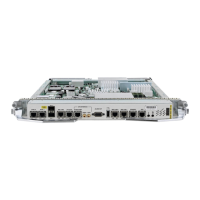Creates a bridge group that can contain bridge domains, and then assigns network interfaces to the bridge domain.
Step 22 bridge-domain bridge-domain-name
Example:
RP/0/RSP0/CPU0:router# bridge-domain test
Establishes a bridge domain and enters L2VPN bridge group bridge domain configuration mode.
Step 23 interface type interface-path-id
Example:
RP/0/RSP0/CPU0:router# interface TenGigE0/1/0/12
Enters interface configuration mode and adds an interface to a bridge domain that allows packets to be forwarded and
received from other interfaces that are part of the same bridge domain.
Step 24 neighbor { A.B.C.D } { pw-id value }
Example:
RP/0/RSP0/CPU0:router# neighbor 125.125.125.125 pw-id 100
Adds an access pseudowire port to a bridge domain or a pseudowire to a bridge virtual forwarding interface (VFI).
• Use the A.B.C.D argument to specify the IP address of the cross-connect peer
A.B.C.D can be a recursive or non-recursive prefix.
Note
• Use the pw-id keyword to configure the pseudowire ID and ID value. The range is 1 to 4294967295.
Step 25 mpls ldp
Example:
RP/0/RSP0/CPU0:router# mpls ldp
Enables MPLS LDP configuration mode.
Step 26 router-id { router-id }
Example:
RP/0/RSP0/CPU0:router# router-id 100.100.100.100
Configures a router ID for the OSPF process.
We recommend using a stable IP address as the router ID.
Note
Step 27 interface tunnel-ip number
Example:
L2VPN and Ethernet Services Configuration Guide for Cisco ASR 9000 Series Routers, IOS XR Release 6.3.x
311
Implementing Multipoint Layer 2 Services
Configuring L2VPN over GRE

